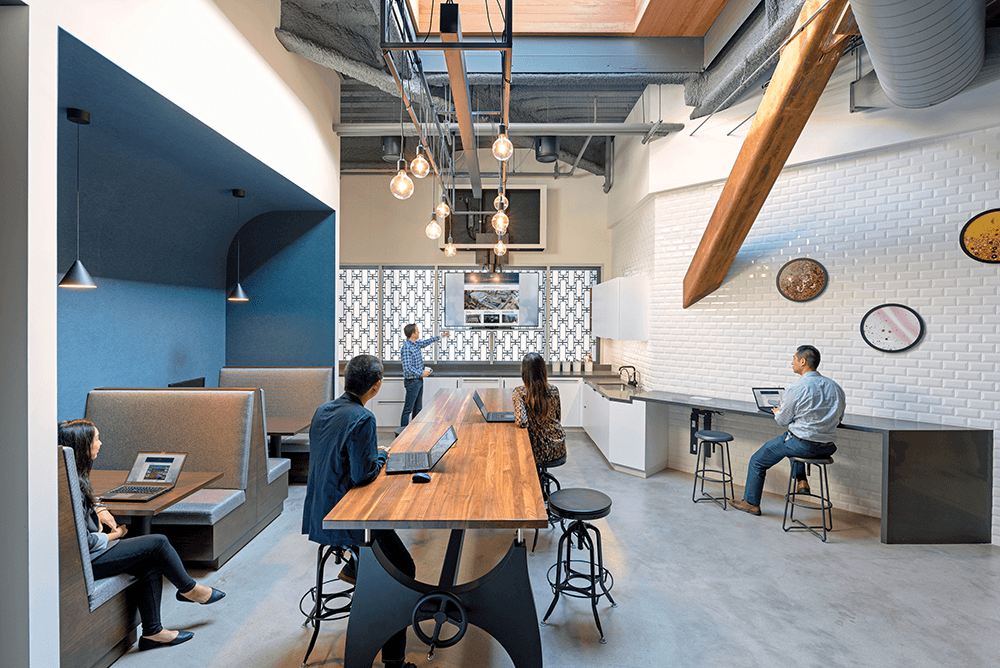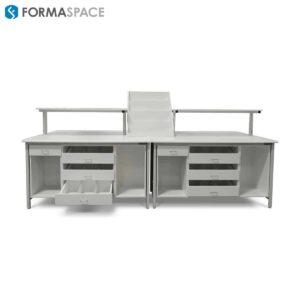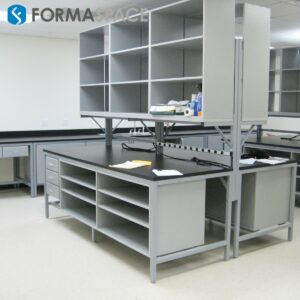As modern office designs shift away from traditional office furniture systems (think cubicles) toward more communal and collaborative work spaces, furniture dealers and reps have had to rethink how they optimize their sales practices. As sales of ancillary furniture (including multifunctional furniture for conference rooms, break rooms, and other collaborative spaces) now exceed the once dominant “primary” furniture systems category, dealers and reps are reaching out to establish sales relationships with a range of new vendors to deliver the kind of distinctive, signature office designs that today’s clients are looking for.

The A&D Community is leading the Way toward New Collaborative Working Styles.
From Apple’s spectacular new futuristic glass and metal headquarters to the industrial-look workspaces of microblogger giant Twitter and fintech innovator Capital One, the entire A&D community is taking a careful note of the revolutionary changes taking place in how we work today.
Creativity, flexibility, and collaboration are the new keywords for today’s modern office designs.
According to Heidi McClenahan, a CRBE Senior Project Manager, this new direction — spearheaded by high-tech startup cultures around the world — downplays job titles and the status of big corner offices in favor of working together in non-traditional settings to solve problems.
In turn, this new attitude toward work is having a profound effect on the furniture sales and distribution markets.
In particular, sales in the ancillary furniture market are zooming ahead — thanks to the popularity of creative and collaborative work solutions for the office. This comes at the expense of traditional “furniture systems,” which are rapidly losing market share to ancillary furniture products.
In order to keep up, more and more furniture dealers and manufacturer’s reps are forging new relationships with non-traditional ancillary furniture manufacturers to expand the portfolio they can offer to their office design clients.
As Ancillary Furniture Sales Outpace Traditional Office System Sales, 40/60 is the new 80/20.
Just how far has the market shifted in favor of ancillary products?
According to commercial office interiors veteran Frank Bucher, Formaspace’s Executive Vice President of Sales, sales of open plan workstations (cubicles, etc.) manufactured by the traditional major furniture manufacturers, such Steelcase, Haworth, Herman Miller, Knoll, etc., once captured 70 – 80% of the project floor plan. In contrast, ancillary furniture, including conference rooms, seating, break rooms, etc., used to only account for 20 – 30% of the overall project floor plan.
Today, these figures are reversed, according to Bucher. Thanks to today’s emphasis on collaborative spaces and the increasing demand for a variety of furniture types that support today’s more mobile workforce, ancillary furniture sales now represent up to 60% of today’s floor plans, with only 40% reserved for traditional open plan office systems, such as office cubicles.
Office Furniture Dealer Reps (DSR’s) Are Expanding their Furniture Portfolio Offerings to Win New Business.
As we’ve seen at the Fall 2016 NeoCon East show held in Philadelphia and the Spring 2017 NeoCon show in Chicago, clients are excited about new trends in collaborative, multifunctional furniture solutions.
With clients gravitating toward more individualistic, unique furniture products, it has given smaller manufacturers, like Formaspace, a rare opening in the marketplace.
However, the prospect of adding new vendors to the mix does pose a challenge to DSRs: How do you find the time to vet these new companies to find unique, differentiated and authentic solutions that will help you win new business from your clients?
The Importance of Performing Due Diligence on Potential New Furniture Vendors.
There are many different ways to approach vetting a new furniture vendor.
In a nutshell, you want to verify that the companies you do business with can be counted on to deliver quality products with reasonable, predictable lead times.
If you are a DSR, one approach is to discuss the opportunity with your management team. Try scheduling an executive factory tour to see the manufacturer’s operations in person.
A well-organized factory tour can answer a lot of questions about a potential new supplier, including:
- Does the organization’s factory operation seem to run smoothly?
- Is their factory floor organized and clean?
- Can they scale up to meet your production requirements for large orders?
- What is their on-time shipment rate?
- What are the lead times for standard, modified, and custom furniture production?
- What are the terms of their product guarantee?
Another tip: Try asking the manufacturer’s industrial design and engineering team a question about an issue you’ve had in the past to get a sense of their ability to solve problems on the fly. If they pass the buck, maybe you should take a pass on them as well. But if they engage you and offer potential solutions to your problem, the chances are good they will help you out next time you encounter a client problem in the field.
The Rules for DSRs are changing: Multiple Vendors, Rapid Project Timelines, and Shorter Office Leases
The role of DSRs is changing in other ways as well.
In many cases, DSRs are taking on new responsibilities to keep projects moving and stakeholders happy.
For example, in a world where multiple vendors are involved in a project, the DSR not only has to be knowledgeable about a greater number of products in his or her portfolio than ever before, they also need to provide their clients with more “logistics services” to make sure all the different deliveries come together on time.
Shorter project timelines are also becoming the norm, which makes it all the more important to find vendors who can deliver quickly and on time.
Another consideration is shorter real estate leases. Whereas the service horizon for a typical contract furniture installation used to be longer than 10 years, today, many clients are gravitating toward shorter, more flexible leases of fewer than 10 years. As a result, many of the ancillary furniture items (such as chairs or seating elements) may be refreshed more often than in the past.
Tip for clients with short leases: Formaspace’s modular desking and benching furniture can be disassembled with simple hand tools into easily transportable flat packs when it’s time for your client to move to a new office space. In fact, some Formaspace desking products don’t require any disassembly at all, making office relocations a breeze.

Trend Spotting: Adopting “Third Space” Design Sensibilities Rooted in the Hospitality Industry
Have you noticed some of these design trends recently?
- Industrial-inspired offices with desking solutions that feel like a warehouse converted into a cool coffee house.
- Ancillary furniture in the office that looks comfy enough to belong in a cozy, well-appointed luxury hotel room.
- “Resi-mmercial” interior design elements that look like they came from a residence with carefully curated furnishings.
- Bold super graphics and lighting in office spaces that makes it feel like a modern art museum.
Indeed, residential and office designs are picking up design cues from “third spaces,” those special places that are neither home nor office.*
*For our purposes, we can classify “third spaces” as part of the hospitality sector.
Clients, as you have no doubt observed, have picked up on these trends and are asking for comfortable, casual, and spontaneous touch-down spaces — made possible thanks to mobile devices that allow you to work from anywhere.
In some cases, DSRs are faced with the challenge of educating clients about the value that well-made, durable contract furniture provides.
As you have no doubt experienced, some clients assume they can just as easily order low-cost furniture from residential manufacturers and suppliers. While that may be possible in limited circumstances (such as for accessory items with short life spans), it can often lead to disappointment for furniture items, such as chairs and desks that aren’t built to accommodate long term use (and abuse!).
Nonetheless, competing with residential furniture is not a good place to be for DSRs. You need to step up to something more unique to get the differential needed to win over the client and close the deal. But how?
Win Repeat Client Business with Bold, Custom Signature Furniture Statements You Just Can’t Buy Off the Rack
To create the ultimate sales differentiation, you need to develop your own signature style.
What do we mean by that?
In our view, Office Furniture Dealer Reps will be more successful if they take the opportunity — over time — to offer their own signature portfolio of products.
And Formaspace can help you do just that.
We have the capability to manufacture fully-custom runs of furniture designed to your specifications. And, since they are built here in Austin, Texas, the lead times are reasonable, and shipping is fast.
Imagine the possibilities.
You can take your expertise and design 100% custom solutions, which we will build to your exact specifications, or you can pitch the opportunity (e.g. design custom furniture) to the architect or interior designer on your next project — an approach that can help you close the deal during the furniture selection process. (What architect or designer will turn down the opportunity to design their own furniture for a major project?)
Want to learn more? Talk with our Formaspace Design Consultants today.
Learn how leading furniture dealers were able to leverage Formaspace’s custom manufacturing capabilities to create custom solutions for name brand companies, ranging from Google to Twitter, to Capital One.
Just fill out the quick form below to get started today.
See original post on FormaspaceOffice.com










